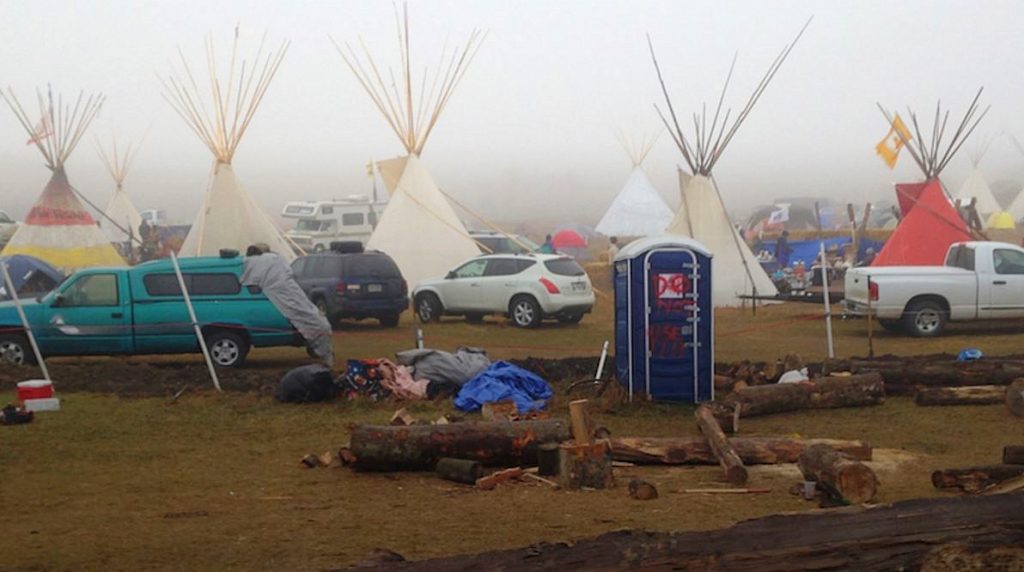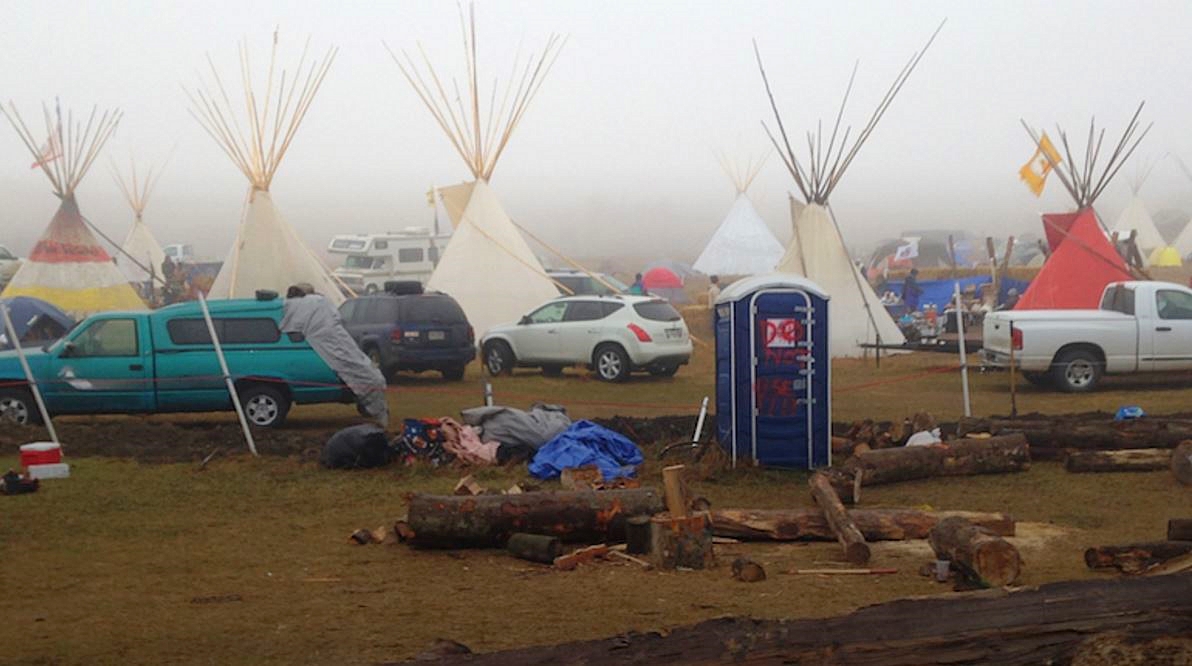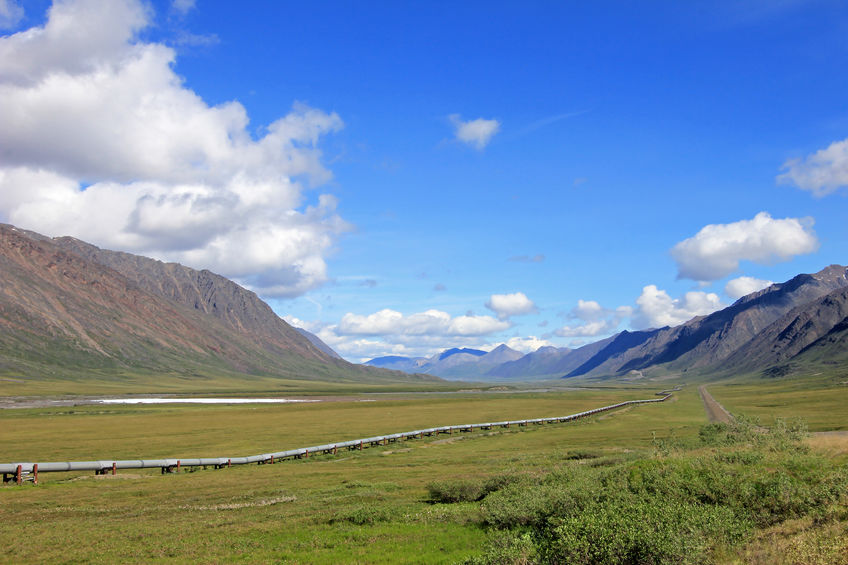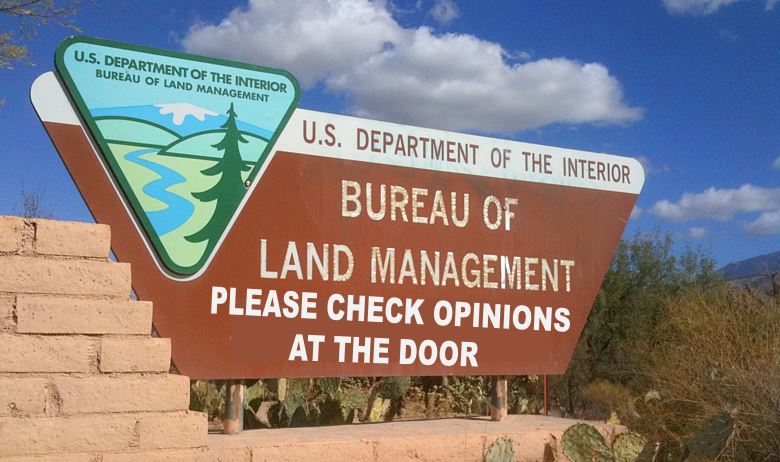Only 3 percent of its length would need federal approval, and in those places the pipeline was designed to run next to existing utility lines, meaning that approval would presumably be hard to deny.
Even in those cases, the company was careful to tread lightly. It made sure that the route would avoid sites that were even being considered for the National Register of Historic Places. It hired professional archaeologists and coordinated with State Historic Preservation Officers and rerouted the pipeline 140 times in North Dakota alone to avoid proximity to cultural resources like burial grounds or ceremonial sites.
Bury Their Future at Standing Rock
the true story of the shutdown of the Dakota Pipeline
Today we’re celebrating. For the first time in U.S. history, the U.S. government is going to honor tribal sovereignty and the treaties that were signed by the U.S. government.” So said Tomas Lopez, a representative of the International Indigenous Youth Council, on the day after the Army Corps of Engineers decided it would not grant an easement through South Dakota’s Lake Oahe for the construction of the last mile of the Dakota Pipeline. Lopez was surely speaking for thousands of protesters who were camped out for months at the Standing Rock Sioux reservation when he declared, “For the first time, I feel like we’re being acknowledged as a people and we’re being seen and being heard and honored.”
No doubt the decision has given some a renewed sense of pride, but whether the administration’s decision was about acknowledging the rights of Native Americans or rather was a final bow to the interests of powerful liberal lobbies in Washington is an open question. And while Standing Rock leaders may be pleased with their success, American Indians will be bearing the devastating economic consequences of this decision for years to come.
The story of the Dakota Pipeline began two years ago, when a company called Energy Transfer Partners applied to build a 1,100-mile pipeline from Iowa to North Dakota in order to carry 570,000 barrels of crude oil per day. The cost was projected at $4 billion. The company went to great lengths to locate the pipeline on almost exclusively private lands. Such negotiations are much easier than those involving public lands, and the many farmers who allowed the pipeline to run across their property were paid handsomely. Only 3 percent of its length would need federal approval, and in those places the pipeline was designed to run next to existing utility lines, meaning that approval would presumably be hard to deny.
Even in those cases, the company was careful to tread lightly. It made sure that the route would avoid sites that were even being considered for the National Register of Historic Places. It hired professional archaeologists and coordinated with State Historic Preservation Officers and rerouted the pipeline 140 times in North Dakota alone to avoid proximity to cultural resources like burial grounds or ceremonial sites. The company also met with the Standing Rock Sioux Tribal Council to present the plan for the pipeline and spoke with the tribe’s historic-preservation officer several times in the fall of 2014.
Ultimately, though, it was up to the Army Corps of Engineers to determine whether the pipeline could go under North Dakota’s Lake Oahe. The Corps has a legal obligation to consult local tribes that could be affected by construction. In 2000, President Clinton signed an executive order requiring all federal agencies to formulate “an accountable process to ensure meaningful and timely input by tribal officials in the development of regulatory policies that have tribal implications.” And in 2009, President Obama reaffirmed this with a follow-up executive order. The Army Corps drafted regulations based on these orders: “Commands will ensure that all Tribes with an interest in a particular activity are contacted and their comments taken into consideration.”
The Corps did just that. As court documents show, beginning in the fall of 2014, representatives of the Corps sent multiple letters to the Standing Rock Sioux tribe and received no response. They attempted to set up a number of meetings and again were met with no response. When they arrived for one meeting, they were told that the conclave had started earlier than expected and was already over. At the next, discussion of the pipeline was removed from the agenda because the Tribal Historic Preservation Officer did not show up.
The following year was also marked by a constant stream of letters from the Corps. Some were answered by Tribal Chief David Archambault, who complained that the tribe was not sufficiently consulted—in response to consultation letters. He noted that because of the tribe’s oral traditions, outsiders could not possibly know where the sites of cultural significance were. Finally, in the spring of 2016, a series of meetings were held between the Corps and the tribe to point out those sites, including one during a visit to the lake itself. The Corps offered a number of concessions and promised that there would be double-walled piping in order to address any concerns about leaks.
The Corps, having held 389 meetings with 55 tribes and having met with the Standing Rock Sioux a dozen times, decided to issue easements to permit pipe to be laid.
Then, in late spring, the tone of the communications shifted markedly. Archambault demanded that the Army Corps reexamine the route of the entire pipeline for potential effects on cultural and environmental resources. When the Corps responded that it had no jurisdiction over the rest of the project, Archambault ended the consultative process. A group of 200 Native Americans launched a protest on horseback and announced that they would not leave the area near the mouth of the Cannonball River, where pipeline construction was under way, until they received assurance that the pipeline would not go near the reservation. “They’re going under the river 500 yards from my son’s grave, my father’s grave, my aunt who I buried last week,” Ladonna Allard, a member of the Standing Rock Sioux tribe, told reporters. “I really love my land, and if that pipeline breaks everything is gone. We must fight every inch of our lives to protect the water.”
On July 26, the Corps, having held 389 meetings with 55 tribes about the project and having met with the Standing Rock Sioux a dozen times, decided to issue easements to permit pipe to be laid through the Mississippi River, Lake Sakakawea, and Lake Oahe. They also put in place a “Tribal Monitoring Plan” whereby representatives of a tribe can be present at all sites of cultural sensitivity while construction of the pipeline is under way.
The next day, the Standing Rock Sioux filed suit, seeking an emergency halt to all construction and claiming they had not been properly consulted. Over the ensuing weeks, a district judge upheld the Army Corps decision and a federal court denied the tribe’s appeal of the ruling against them. Both concluded that the Corps had followed all the proper procedures of consultation and said there was no compelling reason to halt the project.
By this point, though, thousands of protesters had joined the encampment at Standing Rock, including Hollywood near-royalty. The 24-year-old actress Shailene Woodley was arrested for trespassing on private land. Hundreds more protesters were taken into custody after lighting fire to bails of hay. The encampment began to attract everyone who had a beef with the U.S. government or just wanted to join a cause—fighting against racism, for “environmental justice,” and the like. A contingent of anarchists showed up. And then came the usual conflicts between protesters and local law enforcement, with the former claiming they were experiencing police brutality through the use of water cannons and rubber bullets, while the police noted that the protesters were trespassing and endangering local residents.
Meanwhile, the national attention brought to the cause turned Standing Rock into a party. As one Native at the camp complained: “Many of the ‘festival kids’ have come to Standing Rock due to a mix of a deep calling in their hearts, and it being the off-season for festivals. Many arrived with little or nothing to support themselves. No tent, no money, no winter clothing, and no real knowledge on what why [sic] exactly they are here, which makes them an immediate drain on the camps that have been working for months to prepare for winter.”
Thousands of people who were looking for an easier way to signal their own virtue started checking in at Standing Rock on Facebook—the result of a rumor that police were tracking protesters on social media.
By this point, the protesters were making news almost every day. And while the court decisions could have been the end of it—since winter in North Dakota would chase away most of the protesters and the media attention—President Obama decided to keep hope alive.
In early November, weeks after the federal court denied the tribe’s appeal, Obama told news outlets, “We’re monitoring this closely, and I think, as a general rule, my view is that there’s a way for us to accommodate sacred lands of Native Americans.”
It was therefore unsurprising that the Obama administration ultimately stepped in to make that accommodation a reality. “Although we have had continuing discussion and exchanges of new information with the Standing Rock Sioux and Dakota Access, it’s clear that there’s more work to do,” said Jo-Ellen Darcy, the Army’s assistant secretary for civil works, in early December. “The best way to complete that work responsibly and expeditiously is to explore alternate routes for the pipeline crossing.”
The tribe and their supporters celebrated with fireworks. “The Standing Rock Sioux Tribe and all of Indian Country will be forever grateful to the Obama administration for this historic decision,” wrote Chairman Archambault in a statement released by the tribe.
And he should be, because by all rights, Standing Rock should have lost this fight. Even Archambault acknowledged to a crowd gathered after his victory: “That pipeline had every right to go through, but because of the support that we have and the people who gather and are a part of this, we are able to build enough noise to help America understand.”
Energy Transfer Partners and a large coalition of businesses, labor unions, state officials, and private landowners are now left to figure out what went wrong. Did they simply underestimate how much the voice of one tribe mattered in Washington’s decision process? Was there something they should have done differently to address the needs of a group that has been victimized by the federal government for centuries? Perhaps most important: Why did the president place the interests of the Standing Rock over the rule of law?
The President made his interest in Indian issues known early in his tenure. He hosted a White House Tribal Nations conference during each year of his presidency. He started an indigenous youth initiative (Generation I) and has devoted a considerable amount of time to visiting with Native leaders and dedicating discretionary funds to some of their causes. In 2014, Obama was the first president to go to Standing Rock. “I know that throughout history, the United States often didn’t give the nation-to-nation relationship the respect that it deserved,” he told the crowd there. “So I promised, when I ran, to be a president who’d change that—a president who honors our sacred trust, and who respects your sovereignty.”What did Obama mean when he used that term? What does anyone mean when discussing the sovereignty of tribes? As you enter reservations across the country, you’ll find ominous signs warning that you’re subject to the laws of the tribe and the territory. Are you no longer then subject to the laws of the state? Or the federal government? Are you no longer entitled to the protections you enjoy as a citizen of the United States? These may seem like esoteric questions, but such issues are regularly tested in our courts.
One Native leader told me that his tribe would achieve real sovereignty when it was treated the same way it is while playing lacrosse at the World Games—that is, as a nation separate from the United States and respected as its own independent national entity in a “globalized world.”
Tribal leaders continue to claim that tribes are nations apart, but no legal authority takes seriously the idea that the relationship between any Indian community and Washington is the same as the one between Washington and Paris, for example. American Indians are, after all, American citizens.
The problems of Native Americans, it turns out, do not stem from a lack of control over land off the reservations so much as a lack of control on the reservations.
But Native leaders continue to invoke treaties that were signed in the 18th and 19th centuries as evidence of their land rights, as though these lands are not part of the United States. The Standing Rock leaders argue that, even though the land being used for the pipeline is not reservation land, it is land that was promised to the tribe in an 1851 treaty. Other protesters, environmental activists, and academics have echoed this claim. But in Cherokee Nation v. Hitchcock (1902) and Lone Wolf v. Hitchcock (1903), the Supreme Court ruled that treaties signed with Indians could be modified or terminated without Indians’ consent, and no decision has altered that precedent since.In this century, the Court reaffirmed the notion that Indians have no claim to land that sits off of reservations. In a 2005 case, the Oneida Nation claimed that they should not have to pay property taxes on land in upstate New York—land that once belonged to them, but which was sold to white settlers 200 years ago and which they more recently repurchased on the open market. The Oneida argued that because the acreage had been part of their original reservation laws of tribal sovereignty should apply. The court ruled against the tribe, with Justice Ruth Bader Ginsburg writing for the majority that “‘standards of federal Indian law and federal equity practice’ preclude the Tribe from rekindling embers of sovereignty that long ago grew cold.”
Which is not to say there is no such thing as “sovereignty” on Native lands. Indeed, the problems of Native Americans do not stem from a lack of control over land off the reservations so much as a lack of control on the reservations.
Reservations are lands that are held in trust by the federal government. The original goal was to keep Indians contained. Now, it has shifted to preserving these lands for indigenous peoples. But the effect is the same. Indians can’t own any of the reservation territory outright, so they can’t get a mortgage, build equity, or engage in the most basic economic transactions without interference from the federal government. Their lives are micromanaged by the 9,000-person staff of the Bureau of Indian affairs.
One Crow man I spoke to was trying to purchase a few acres of land from his neighbor, another Indian, on which to graze some cattle. The two had agreed on a price but then a representative of the Bureau of Indian Affairs told them that the deal couldn’t go through because the price they had agreed on was not “fair market value.” The agency had recently commissioned an appraisal of land on the reservation and apparently told the appraiser to overvalue the land so as not to “screw the Indians.” Which is, of course, exactly what happened.
The result of rampant governmental mismanagement and the lack of property rights has been the kind of poverty that one would only expect to find in the Third World. People live in tents through winters in North Dakota. There are large extended families piled into single-trailer homes. Trash is everywhere. American Indians have higher rates of poverty, unemployment, gang violence, alcohol abuse, rape, and child sexual abuse than any other racial or ethnic group in America. Indeed, one reason for the kind of support that the Standing Rock protesters have received is that these conditions and these statistics are simply shocking to most Americans who are learning of them for the first time.
There are tribes that have clawed their way out of poverty—some with casinos. But others are trying to make use of natural resources, since it turns out that the same lands that Indians were forced onto in the 19th century because they were worthless for farming have turned out to be rich in oil, gas, and coal.
Indian reservations, Terry Anderson and Shawn Regan wrote in Louisiana State University’s Journal of Energy Law and Resources, “contain almost 30 percent of the nation’s coal reserves west of the Mississippi, 50 percent of potential uranium reserves, and 20 percent of known oil and gas reserves”—resources worth nearly $1.5 trillion, or $290,000 per tribal member. Tragically, “86 percent of Indian lands with energy or mineral potential remain undeveloped because of federal control of reservations that keeps Indians from fully capitalizing on their natural resources if they desire.”
Indeed, there is much that the Obama administration could have done to help the tribes that actually want to engage in more extraction. Instead they have allowed the Bureau of Land Management to run roughshod over tribes when it comes to controlling their reservations. Commenting on the administration’s new “venting and flaring” rules, which make natural-gas extraction more expensive and complicated, the leadership of the Ute tribe wrote, “This kind of paternalism is not the modern role of the federal trustee and not the kind of trustee that President Obama has directed for his Administration.” On the same rules, the Mandan, Hidatsa, and Arikara Nations have noted that “consultation to date has not been meaningful.”
Regarding new administrative rules on fracking, the Navajos have written, “The breadth and depth of BLM outreach and consultation with Indian Country has been insufficient given the potential impact the rule could have on tribal energy resources and economic development.” The Crows have noted, “Tribal lands are under the jurisdiction of sovereign tribal governments and are for the benefit of tribal members. However, BLM continues to treat tribal lands like public land by trying to regulate oil and gas development on tribal lands.”
Because there is no army of protesters whose members want to make sure that American Indians can engage in fracking on their own land, these tribes will never get the kind of support that the Standing Rock tribe has.
All of these tribes have expressed support for a bill called the Native American Energy Act, which would allow them more independence when it comes to using their own natural resources. But Obama promised that if the bill came to his desk, he would veto it because it “would not ensure diligent development of resources on Indian lands.” Diligent development, apparently, requires more federal oversight on Indian land than it does on private land because . . . what? Because Indians aren’t capable of making decisions as well as white owners of land?
What’s obvious from the president’s statements and policies is that decisions about what happens on Indian land have little to do with any concern for Indian sovereignty or the well-being of tribes, which could really use the money and the jobs that would come from such development. These policies are merely an extension of the president’s environmentalist politics. Whether it’s the Keystone Pipeline or the Dakota Pipeline, the problem is the pipeline. Both would supposedly destroy the supposedly pristine environment that the president’s green lobby wants to support. If blocking one means also being able to claim the mantle of support for indigenous rights, well, so much the better.
In the state of Washington, the Gateway Pacific Terminal project has pitted one Indian tribe against another. The Lummi Nation has demanded that the U.S. Army Corps of Engineers deny the permit application necessary to build a pier because it endangers the tribe’s fishing rights. But the impoverished Crow tribe has supported the project because it needs a way to transport coal that it is extracting from the Powder River Basin. Guess which tribe the outgoing administration has sided with?
Members of the Navajo, Ute, and Paiute tribes have objected to the president’s plan to designate a national monument in the Bears Ears area of Southern Utah. Such a designation—which has been widely supported by environmentalists eager to turn the land into a playground for the wealthy—would restrict farming, mining, and oil and gas drilling that currently benefit tribe members. But the objections of these Natives have been ignored by the administration.
Tribes that would like to see more economic development on their lands are cautiously optimistic about the incoming Trump administration. Certainly there is hope that the decision to halt the Dakota Pipeline—which other tribes not only support but were actually planning to use in order to transport their own oil—will be overturned.
But in the meantime, President Obama has ushered in a new era of regulatory uncertainty. The next time a private firm wants to undertake any kind of construction project, it will know to keep its economic activity as far away from Indian country as possible. Many companies are already reluctant to do business with tribes because of various legal uncertainties, but now they will be less likely to locate industry in an area where Indians could potentially see jobs or feel any economic boost.
In his speech to the final White House Tribal Nations Conference, President Obama told the Native leaders, “I hope I’ve done right by you.” Actually, just like his predecessors from centuries past, he’s managed to screw the Indians, too.
Naomi Schaefer Riley




